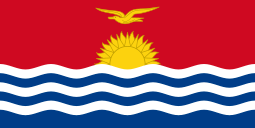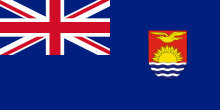Flag of Kiribati
 | |
| Use | National flag and ensign |
|---|---|
| Proportion | 1:2 |
| Adopted | 12 July 1979 |
| Design | A horizontal bicolour of red and blue with the yellow frigate bird flying over the rising sun with seventeen rays centered on the upper half and three white wavy horizontal stripes on the lower half. |
 Variant flag of Kiribati | |
| Use | historical |
| Proportion | 1:2 |
| Adopted | May 1937 |
The flag of Kiribati is red in the upper half with a gold frigatebird (Fregata minor, in Gilbertese: te eitei) flying over a gold rising sun (otintaai), and the lower half is blue with three horizontal wavy white stripes to represent the ocean and the three groups (Gilbert, Phoenix and Line Islands). The 17 rays of the sun represent the 16 Gilbert Islands and Banaba (former Ocean Island).
The frigatebird symbolises command of the sea, power, freedom and Kiribati cultural dance patterns, the blue and white wavy bands represent the Pacific Ocean, which surrounds Kiribati and the sun refers to Kiribati's position astride the Equator.
The badge was designed by Sir Arthur Grimble in 1932 for the Gilbert and Ellice Islands British colony.
Kiribati's flag is an armorial banner, a flag having a design corresponding exactly to that of the shield in the coat of arms.
The coat of arms dates back to May 1937 when it was granted to the Gilbert and Ellice Islands, as Kiribati and Tuvalu were then known. The shield was incorporated into the centre of the fly half of a British Blue Ensign as the state ensign of the colony.
Shortly before independence was granted in 1979, a local competition was held to choose a new national flag, and a design based on the colonial coat of arms was submitted to the College of Arms. The College of Arms decided to modify this design. Both the golden frigatebird and the sun were enlarged to occupy more of the top of the flag, and the width of the blue and white wavy bands was reduced. The local people, however, insisted on the original design, in which the top and bottom halves of the flag were equal, the sun and local frigate bird small, and the various design elements outlined in black. The new flag was hoisted during the independence day celebrations in the capital, Tarawa, on 12 July 1979.
The flag bears a very slight resemblance to the flag of the Latvian Soviet Socialist Republic, as well as to the flag of British Columbia, the Flag of the Isle of Wight, the flag of the Company of Scotland, and the flag of the city of Bath, Maine.